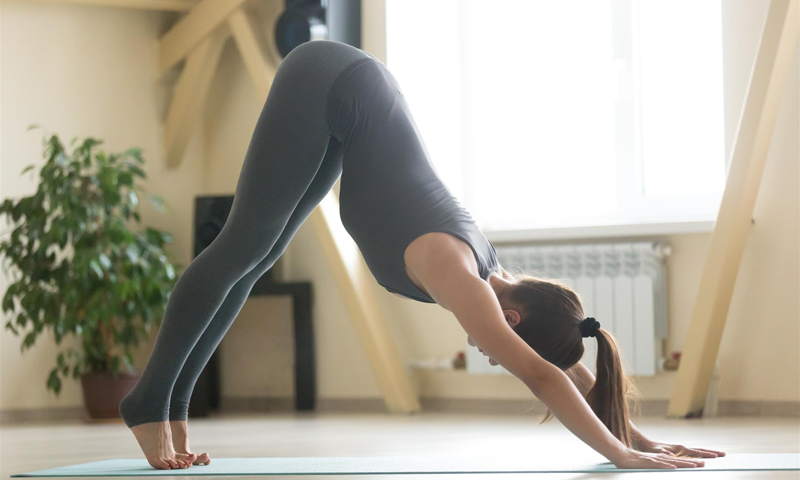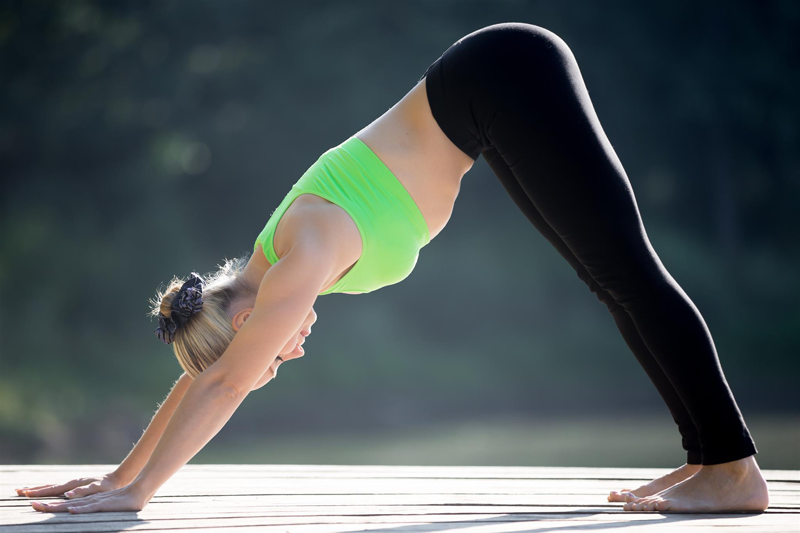
How to do corpse pose in yoga
26th June 2018
What Does a Beauty Routine Look Like for a Yogini?
28th June 2018How to do Downward-Facing Dog pose in yoga

The downward-facing dog is the pose in yoga that will elicit the most laughs from those watching on – and there is certainly an argument for wearing one of our sports bras! You are essentially sticking your butt in the air! Is it particularly amusing being asked to do this looking into the middle of the yoga space, as opposed to the wall. Yoga is about changing your perspective on life… but seeing everyone else with their head between their knees and their butt up might not be what is meant here!
Some of us might be surprised to hear that this is a resting pose. Adho Mukha Svanasana is a standing pose with a mild inversion that helps build strength, whilst stretching the whole body – and it can feel difficult, especially as instructors often leave you there a good long time.
The benefits of this pose
Even though it is considered a resting pose, its benefits are there to rejuvenate and energise the entire body. It will stretch your hamstrings, shoulders and calves. You will also feel the stretch in your arches, hands and spine. This is often why the teacher will move you into downward-facing dog after a strenuous pose.
However, this pose can also build strength in your arms, shoulders and legs – and because your heart is higher than you head – it is a mild inversion, meaning it is great for getting blood to the head. This gives the benefits of reducing headaches, fatigue and insomnia – and helping to calm the nervous systems, improving memory and concentration, and relieving anxiety and even mild depression. This is the pose the dog takes when it wants to play… you never see an unhappy dog in this pose!
It has also been reported to benefit digestion, ease back pain, help with sinusitis, asthma, flat feet and the menopause. So, all in all, a useful yoga pose!
Instructions
- You should begin on your hands and knees. Make sure that your knees are directly under the hips and the hands beneath the shoulders.
- The fold of your wrists should be parallel with the top of your mat, remember to point your middle finger to the top of the mat to help you achieve this. Spread the rest of your fingers to give you a stable base.
- Stretch your elbow. Now, relax your upper back. Press firmly through your palms, spreading the weight evenly through the hands.
- Breath out and now lift your knees off the floor. You should be pushing your pelvis towards the ceiling. Draw your seat towards the wall behind you and straighten the legs – but do not lock the knees!
- Push the floor away from you, evenly through hands and feet, as you lift up through your pelvis.
- Straighten your spine and broaden your collarbone.
- Rotate your arms so your elbows are facing your thumbs. Push the chest down towards your thighs.
- As you are doing each of these modifications, you should continue to push evenly through the floor with hands and feet.
- Engage your quads and sink your heels to the floor.
- Align ears with the upper arms and relax the head, letting it dangle… and hold… for what will feel far too long but keep going up to 100 breaths.
- Release and move gently back to your knees.

Tips
In some regards, your body is unique to you and bringing your body into perfect alignment will be different to your teachers and to the person next door to you. Therefore, when you are trying out this pose, you are not making mistakes as such, you are working out what works for you.
However, there are some common misalignments, which makes downward-facing dog uncomfortable or ineffective. First, if the hands and feet are not rooted it can put stress on the ankles and on the wrists. Therefore, remember to space out the fingers and the toes and keep the hands and feet at hip and shoulder width. It might be an idea to start with the alignment of the plank before moving into the downward-facing dog.
Another common misalignment is the tendency for the shoulders to scoot up to the ears. Then, to realign people often poke their elbows out a little. A great tip is to stretch down through the neck to keep the shoulders away from the ears – and then relax the jaw. If this doesn’t work rotate the shoulders in their joints a little, pushing backwards.
Finally, you should be an inverted V shape, as opposed to standing with a rounded back. Therefore, you need to walk your hands and feet a little closer to each other – and then strive to put your heels on the floor.
Be aware that downward-facing dog can exacerbate problems of carpal tunnel syndrome in the wrist – therefore, it should be avoided if you struggle with this condition. It is also not a position advised for women in late pregnancy or people with particularly high blood pressure.
Modifications and Variations
This might seem a simple pose, but it is a good idea to warm up before spending too much time inverted. You should warm up and stretch the hip area – and bend the knees some whilst stood on the balls of your feet.
It is possible to make this pose more challenging. Imagine your downward-facing dog needs to take a pee up a tree and lift one of the legs off the ground as high as possible. This three-legged dog adds a little more challenge to the inversion. You can also add more power into the pose by gripping a yoga block between the thighs…
If, instead, you want a more restorative pose, place a block under the head so that the neck can rest without strain. You can find some excellent yoga blocks in our shop.
To perfect the pose
Practise makes perfect – and works to increase the blood flow around the body. So, attempting a downward-facing dog at different parts of the day is no bad thing. It can really offer a great full-body stretch and keep your mind calm – even when you are away from your mat.

